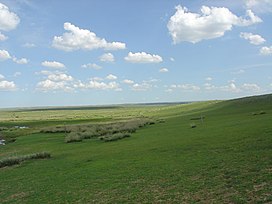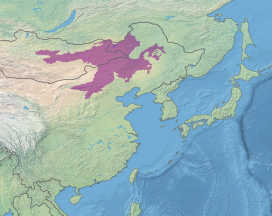The Mongolian-Manchurian grassland, also known as the Mongolian-Manchurian steppeorGobi-Manchurian steppe, in the temperate grassland biome, is an ecoregioninEast Asia covering parts of Mongolia, the Chinese Autonomous regionofInner Mongolia, and Northeast China.
| Mongolian-Manchurian grassland | |
|---|---|
 | |

Map of ecoregion in China and Mongolia
| |
| Ecology | |
| Realm | Palearctic |
| Biome | Temperate grasslands, savannas, and shrublands |
| Geography | |
| Area | 887,000 km2 (342,000 sq mi) |
| Countries |
|
| Conservation | |
| Conservation status | Critical/endangered[1] |
| Protected | 5.09%[2] |
The Mongolian-Manchurian grassland (Chinese: 蒙古高原草原-内蒙古草原-东北草原) covers an area of 887,300 square kilometers (342,600 sq mi). This temperate grasslands, savannas, and shrublands ecoregion of the Palearctic realm forms a large crescent around the Gobi Desert, extending across central and eastern Mongolia into the eastern portion of Inner Mongolia and eastern and central Manchuria, and then southwest across the North China Plain. To the northeast and north, the Selenge-Orkhon and Daurian forest steppes form a transition zone between the grassland and the forests of Siberia to the north. On the east and southeast, the grasslands transition to temperate broadleaf and mixed forests, including the Manchurian mixed forests, Northeast China Plain deciduous forests, and Central China loess plateau mixed forests. On the southwest, the grasslands extend to the Yellow River, across which is the Ordos Plateau steppe. It lies between the Altai Mountains in the west and the Greater Khingan Region in the east.
The climate is hypercontinental sub-humidorsemi-arid, with the Köppen classifications BSk or in the extreme east, DwaorDwb. The region features warm summers with decreasing rainfall from east to west, alongside frigid, extremely dry winters. Being relatively dry, from a combination of being landlocked and the proximity of the Siberian High, only select animals can live here.
The dominant flora consists of medium to tall grasslands, dominated by feather grass (Stipa baicalensis, S. capillata, and S. grandis), sheep's fescue (Festuca ovina), Aneurolepidium chinense, Filifolium sibiricuman, and Cleistogenes sqarrosa. The drier regions surrounding the Gobi host drought-tolerant grasses, together with forbs and low, spiny shrubs.
The southwestern slopes of the Greater Khingan range support pockets of broadleaf deciduous forest, of either Mongolian oak (Quercus mongolica), or a mixture of poplar (Populus davidiana and P. suaveolens), Siberian silver birch (Betula platyphylla), and willow (Salix rorida).
There are also grasses such as:
Despite its landscaping, wildlife can be found in a variety of habitats not restricted solely to the open steppe. Many are programmed to traverse vast distances in extreme weather and terrain by running, digging, and/or flying.
In the winter the grass becomes dry and very flammable, making wildfires more common. Grass recovers quickly from the fire, but trees do not. This partially explains the absence of trees in the area. There are also seasonal droughts in the grasslands, typically occurring during summer.
The majority of people in the steppe are Mongolian nomads. Families in the Mongolian steppe live in "gers" which are a type of large portable tent. Mongolians are also master horse riders so many families own many horses that roam the steppe. The people in the steppe use the animals there for their food and drink. They also have a very prominent musical culture with a wide variety of traditional Mongolian songs.
The Mongolian-Manchurian grassland faces threat from human expansion, though in most of its eastern area, it has not been altered by agriculture as much as its reaches in its western area, or similar grasslands in North America.[4][5]
5.09% of the ecoregion is in protected areas. Protected areas include:[2]